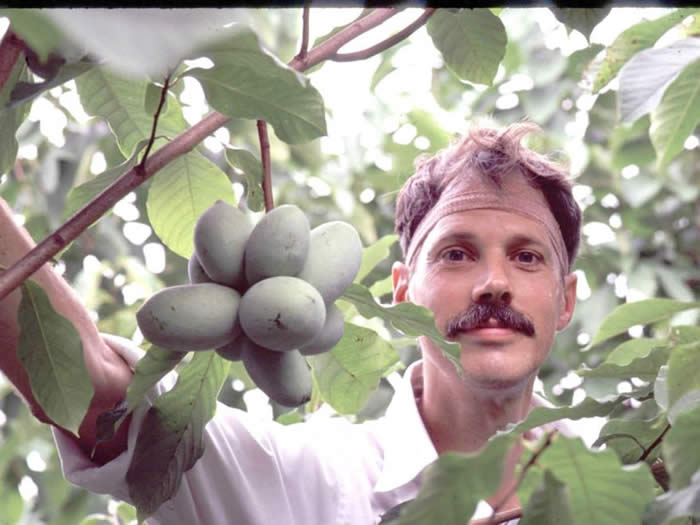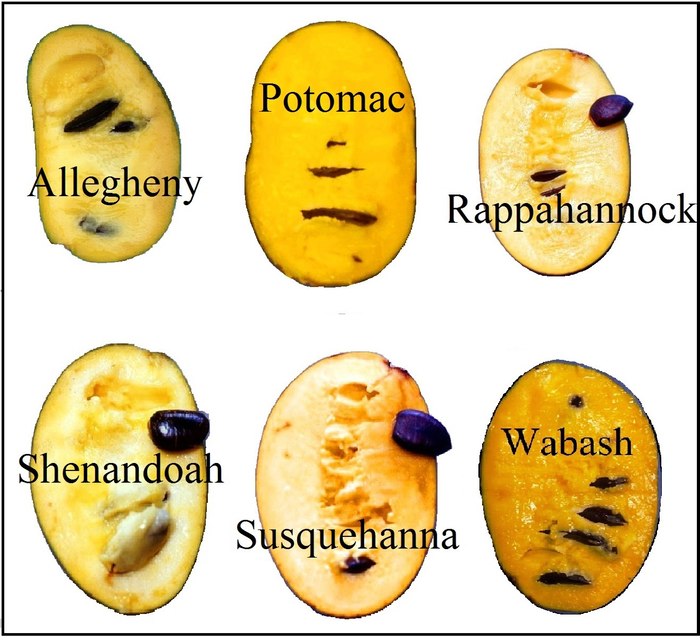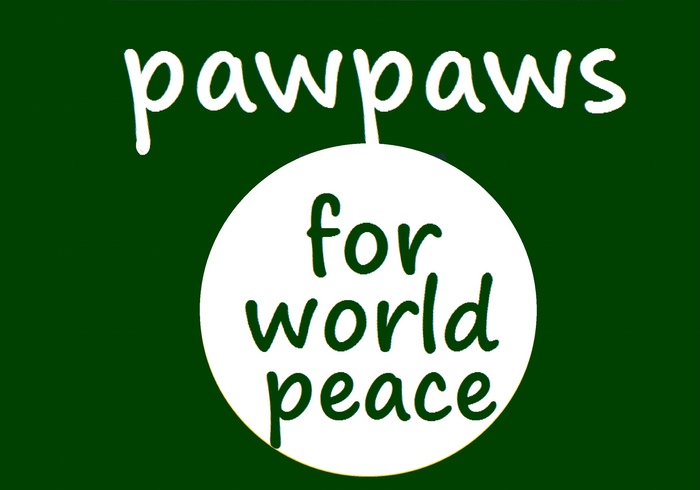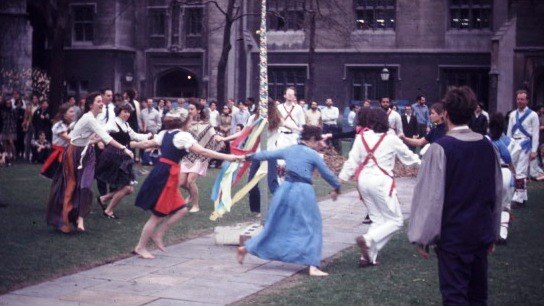From Peterson Pawpaws
by Neal Peterson
The History of Peterson Pawpaws

September
1976 — It was 38 years ago, and I was a grad student at West
Virginia University, that I tasted my first pawpaw on the banks of the
Monongahela River — a life-changing revelation! Like Saul on the
road to Damascus. What an epiphany of flavor. Suddenly I found myself
imagining pawpaws as a new fruit crop on par with peaches and pears.
Since then I have been devoted to the cause of bringing the pawpaw — this Asimina triloba
that is unique to eastern North America, our largest native edible
fruit — out of the woods and into the realm of agriculture, into
our backyards, onto our dinner tables, and into our local farmers
markets. And ultimately, someday, into the grocery stores.
It
took me several years to track down the historic pawpaw collections of
the early 20th century. I selected the best pawpaws as a source of
seed, and then used old-fashioned breeding methods as practiced by
farmers for thousands of years. Plant the seeds; grow them to maturity;
have a clear objective. In my case the first objective was fewer seeds,
because the seediness of wild fruit is a turnoff to customers if you
plan to put pawpaw fruit in the market. My other objectives were
flavor, size, and yields.
Think of the wild strawberry (Fragaria virginiana)
: Its flavor is incredible – so sweet – so intense –
but their fruit is only thimble-sized and their yields are modest.
Strawberries could not become a real crop until breeding had improved
their size and productivity. The same is true of pawpaws: selecting for
overall excellence, retaining the flavor but reducing the quantity of
seeds and enhancing the fruit size. That is what I have done.
 | | Comparison of wild (left) vs Peterson variety (right) |
We
still have a ways to go to bring pawpaws into our homes, but thankfully
I have accomplished a great deal already. In 1998, I released to the
public six fabulous varieties of pawpaw (shown below), 6 out of 1500
seedling trees I had examined over an 18-year period. These Peterson
Pawpaw varieties are now available in the US from seven nurseries.
Many
gardeners around the world have begun to take note of our pawpaw
— and covet it. It may seem ordinary to us here but they value it
as an exotic luxury fruit. They compare it to the tropical annona
fruits, such as the cherimoya, sweetsop, soursop, and custard apple.
The pawpaw (Asimina triloba)
their northern cousin, shares great similarities in flavor and texture.
But it is vastly hardier. No other member of the Custard Apple Family
(Annonaceae) can withstand freezing winter temperatures while pawpaw is
hardy to -20F (-30C).
Europeans have approached me for years.
They have read about me and my varieties on blogs and in horticultural
news; they say my pawpaw varieties are the best in the world. They want
my varieties. But I always decline. The requirements of international
trade are very expensive. Bare-root shipment of trees is required
— a sure way of killing a pawpaw. The proper method of supplying
quality pawpaws abroad is through nursery production in the countries
of interest.
Of course, people in foreign lands are already
growing pawpaws from seed, but pawpaws don’t come true to seed
and hence, on the whole, resulting seedlings will be ordinary —
with seedy fruit, average flavor, and mediocre size. To propagate a
named variety one must do grafting.
With all modesty aside, my
varieties are the best; they deserve to be in Europe and Japan where
they will do the most good to popularize the fruit. With your help, we
at Peterson Pawpaws can make our pawpaws part of farming and eating
around the world.
Closing Thoughts
Other
North American species have been brought in from the wild. The
blueberry was domesticated only recently in the 1920's and 1930's in
New Jersey; and the pecan only about 50 years before that. And now the
blueberry is recognized to be so healthful and has become so popular.
The pawpaw is as nutritious as the blueberry, and contains many
antioxidants. And in addition, the pawpaw is little bothered by insect
pests or diseases (unlike apple for instance). It is well-suited to
organic agriculture.
In any case, my work will go on as I pursue
breeding and hybridization. Potent pawpaw possibilities continue to
inspire me, and keep me going all these many years in my quixotic
scientific endeavor that has been a personal calling. But by no means
have I labored alone. I have had plenty of help both physical, mental
and moral along the way — and you friends know who you are, and I
thank you! — but it has required great patience and
stick-to-itiveness.
To Advance My Work Further I Need Your Help!

Global Opportunities for Peterson Pawpaws
Two
prominent nurseries, one in Europe and the other in Japan, in response
to growing public demand for pawpaws, have done their research and
concluded that Peterson Pawpaw's six varieties are the best in the
world! They are ready to make them widely available. License contracts
have been agreed upon. Propagating wood has been sent. Just one final
hurdle remains …
Trademarks: The Last Hurdle
International
trademarks are required in order to secure these contracts in the EU
and Japan. Without protected names for the plants, anyone can grow and
sell any old pawpaws under my names. Selling inferior products is not
the way to popularize a new exotic fruit, bringing it into agriculture
and into homes and restaurants. In fact it is a good way to kill a
fledgling market. The trademark process is expensive. I need $20,000 to
cover all expenses. The two biggest expenses are governmental fees and
the related attorney fees. The next expense is reward fulfillment.
Finally, we must allow for the standard commissions of Kickstarter and
Amazon.
In addition to giving, the very best way to help is to
spread the word to all your friends, especially if they love fruit and
American history ... and who doesn't love fruit! We will be deeply
grateful if you pass this on via email, Facebook, Twitter. Help bring
the best pawpaws to the rest of world.
The Deal with Trademarks
Our
Object: To make Peterson Pawpaw varieties widely available abroad in
Japan and Europe through license agreements with nurseries in those
countries, and trademarks therein. And available later in Chile, New
Zealand, and other countries with temperate climates where pawpaws can
grow.
Pawpaws have become a hot item in Europe and Japan where
they are experienced as an exotic luxury. The two nurseries I mentioned
have done their research, and concluded that my varieties are the best.
They want them! We have reached agreement on licensing contracts, but
face one last expensive hurdle, trademarks.
The nurseries
require Registered Trademarks in their respective countries. In the
absence of trademarks they will cancel the contracts. They need these
trademarks, naturally, for their marketing campaigns. No serious
company will engage in production without planning for marketing. And
trademarks are the basic means of securing market protection against
unscrupulous competitors.
In the absence of trademarks,
competing nurseries may sell pawpaws under Peterson Pawpaw variety
names. They will be selling counterfeits. The visibility and excellent
reputation of my varieties are incentive for them to do so. But of
course, this unethical behavior will harm licensed nurseries as they
lose sales, and will harm the customers who buy inferior products.
These
varieties are my creation and belong to me. Hence it is my
responsibility to apply for the trademarks at my expense. I own US
trademarks but these do not cover commerce beyond US borders.
Unfortunately, foreign trademarks are very expensive, much more
expensive than US trademarks.
I turn to you generous Kickstarter
folks for help. I need $20,000 to cover all expenses. The two big
expenses are governmental fees and the related attorney fees. (NOTE: I
have already retained reputable attorneys in the Netherlands and
Japan.) The next two expenses are reward fulfillment and overhead.
Finally, we must allow for the standard commissions of Kickstarter.
PLEASE SHARE
The
very best way to help, in addition to giving, is to SPREAD THE WORD to
all your friends and family, especially if they love fruit and American
history ... and who doesn't love fruit! We will be deeply grateful if
you pass this on via email, Facebook, Twitter. Help bring the best
pawpaws to the rest of world.
PAWPAWS TO THE PEOPLE!

February 18, 2015
Great news! We broke the sound barrier!
Dear Friends of Pawpaws,
That
means: We reached our goal of $20,000. All of you who helped us deserve
praise for this. We couldn't have done it without you. You should know
that not every Kickstarter project succeeds. It was you, our backers,
who did it.
Eight more days exist before the final deadline of
Feb.25. Our project is still open for receiving pledges. There are
expenses for my research that I didn't list, and didn't add into the
goal ... because the higher one sets the goal, the greater the risk of
not reaching it at all. (And with Kickstarter if you don't reach the
goal you get nothing.)
So please pass the word along to friends
and family. You never know who might take an interest in pawpaws.
Continued giving will enable me to meet various expenses, most
importantly to pay my three team workers for their steadfast assistance
that started back in October. You can see the faces and bios at the
bottom of my project page.
Best wishes, Neal
Success Success!
February 25, 2015
Successfully raised $22,357 USD with 248 backers

Back to
Neal Peterson's Breeding Program
Pawpaw Page
|
|